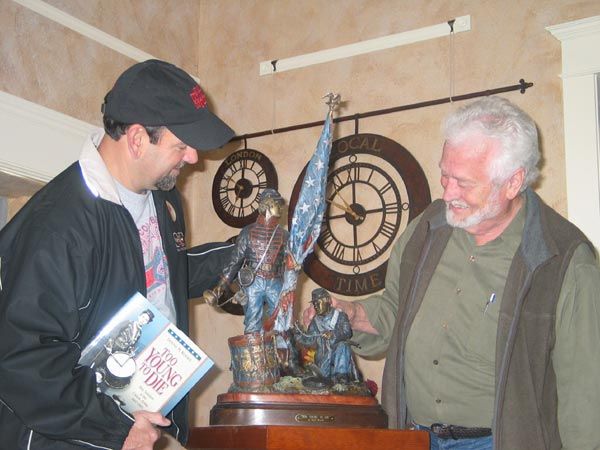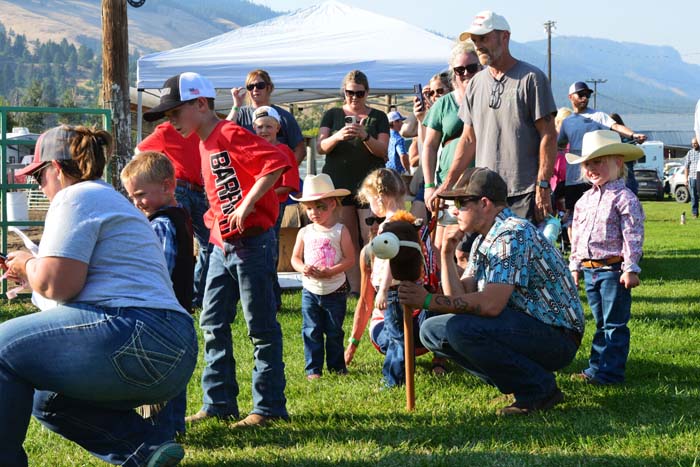Collaboration complete: Sculptor meets author whose book was basis for bronze piece
Published 3:00 pm Monday, October 27, 2008

- Dennis Keesee, left, and David Manuel examine the bronze sculpture âToo Young To Dieââ at Hot Lake Springs Friday. Manuel made the sculpture, which shows boys serving in the Union Army during the Civil War. Keesee is the author of a book about Civil War boy soldiers also named Too Young To Die. Manuel frequently referred to Keeseeâs book while making his sculpture. The Observer/DICK MASON
They are the forgotten heroes of the Civil War.
Trending
Boys too young to shave but not too young to die serving their country.
Youths who, 140 years after their courageous service, caused the
paths of Hot Lake sculptor David Manuel and Ohio author Dennis Keesee
Trending
to intersect Friday.
Manuel recently completed a bronze Civil War sculpture, “Too Young To Die,” which portrays two boys in their early teens serving in the Union Army. One is a drummer and bugler and the other a medic. The bronze is on display at Hot Lake Springs, which Manuel and his wife Lee are restoring.
Manuel created the sculpture based primarily on information from Keesee’s 2001 book “Too Young To Die: Boy Soldiers of the Union Army 1861-1865” (Blue Acorn Press). The book is about the boys under 18 who served in the Civil War.
The La Grande artist and sculptor consulted Keesee’s book constantly while completing his work.
“Ninety-five percent of my information came from (the book) ‘Too Young To Die,”’ he said.
Manuel asked Keesee to come to Hot Lake and see his sculpture. Keesee accepted the invitation and visited this weekend, coming for the
Hot Lake Springs Fall Festival, where he participated in a book signing. Keesee said Manuel’s piece is flawless. He knows of no other sculptures of boys serving in the Civil War that are close to being as historically authentic as Manuel’s.
“It is amazing,” Keesee said.
He marvels at Manuel’s painstaking attention to historic detail. The drum and uniform in the sculpture are exact replicas of the federally issued ones during the Civil War. The bugle shown is the precise three-piece model made in the 1860s, and even the canteens both boys have are exactly like the kind used by the Union Army, he said.
They are mirror reflections of things such as the actual Union Army drum and uniform Manuel purchased to base his bronze sculpture on.
Keesee could spend more than an hour discussing the sculpture’s authenticity. He agreed that it looks so true to life that it gives a three-dimensional element to his Civil War book – a volume that was a labor of love to produce.
“History is my passion,” Keesee said.
He spent 15 years collecting materials for and writing his book. The work tells a story often overlooked but so worth recounting. Keesee said that 200,000 of the Union Army’s soldiers were under 18, about 10 percent of it troops.
The total includes a number of boys who were 12 and younger. The Union Army set 12 as its minimum age for enlisting, which meant that boys as young as 10 could lie about their age and enlist, Keesee said.
Recruiters, paid $2 for each soldier they signed up, were not zealous about checking the boys’ true ages.
Soldiers in their early teens often served as drummers for Union Army squads since they were too young for combat. Still, the young drummers were often shot at. Manuel’s sculpture reflects this; the drummer has a wound the medic is treating.
Young boys were popular members of Union Army units.
“Many of the men (in the Union Army units) had sons the same age back home. They looked at them as examples of who they were fighting for,” Keesee said.
“Too Young To Die” features 213 photographs and illustrations, one of the largest compilations of boy-soldier photographs ever assembled.
It features several photographs of John Lincoln Clem, the most famous of the boy-soldiers, remembered as the “Drummer Boy of Chickamauga.”
Clem joined the Union Army in his early teens and fought in many battles with the 22nd Michigan Infantry. Clem remained in the army after the Civil War before retiring in 1915. He was the last man on active duty who had fought in the Civil War when he retired.
Manuel, like Keesee, was inspired to create his work because of his passion for history. Incredibly, he named his piece “Too Young To Die,” and was halfway done with it before learning that Keesee had written a book with the same title.
“How amazing is that?” Lee Manuel said.
David Manuel and Keesee may collaborate again in the future, this time intentionally. Keesee is working on another history book and is interested in having David Manuel make a sculpture to complement it.
The fall festival Keesee appeared at Saturday was attended by about 500 people, including a number from the East Coast and even Switzerland. Many of the works Fall Festival visitors saw Saturday will be displayed at the Hot Lake Springs Museum, which will open in the spring of 2009.









